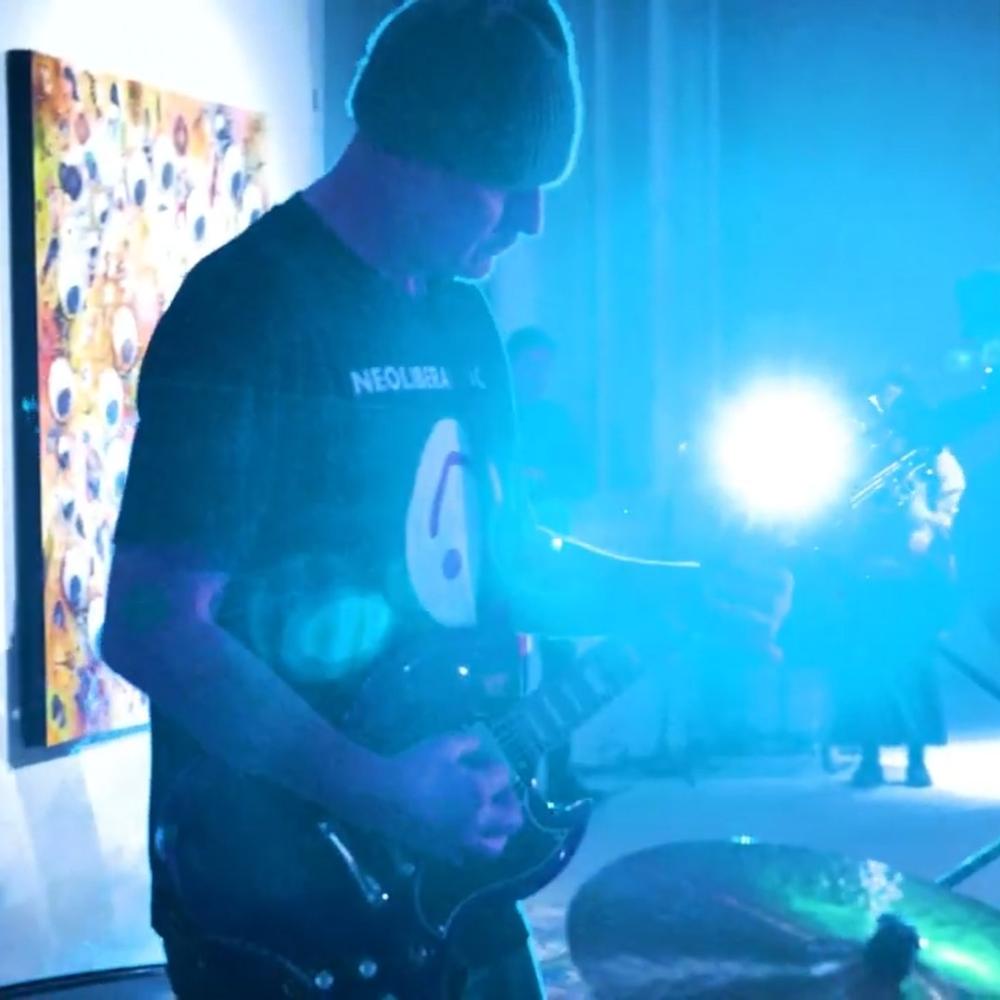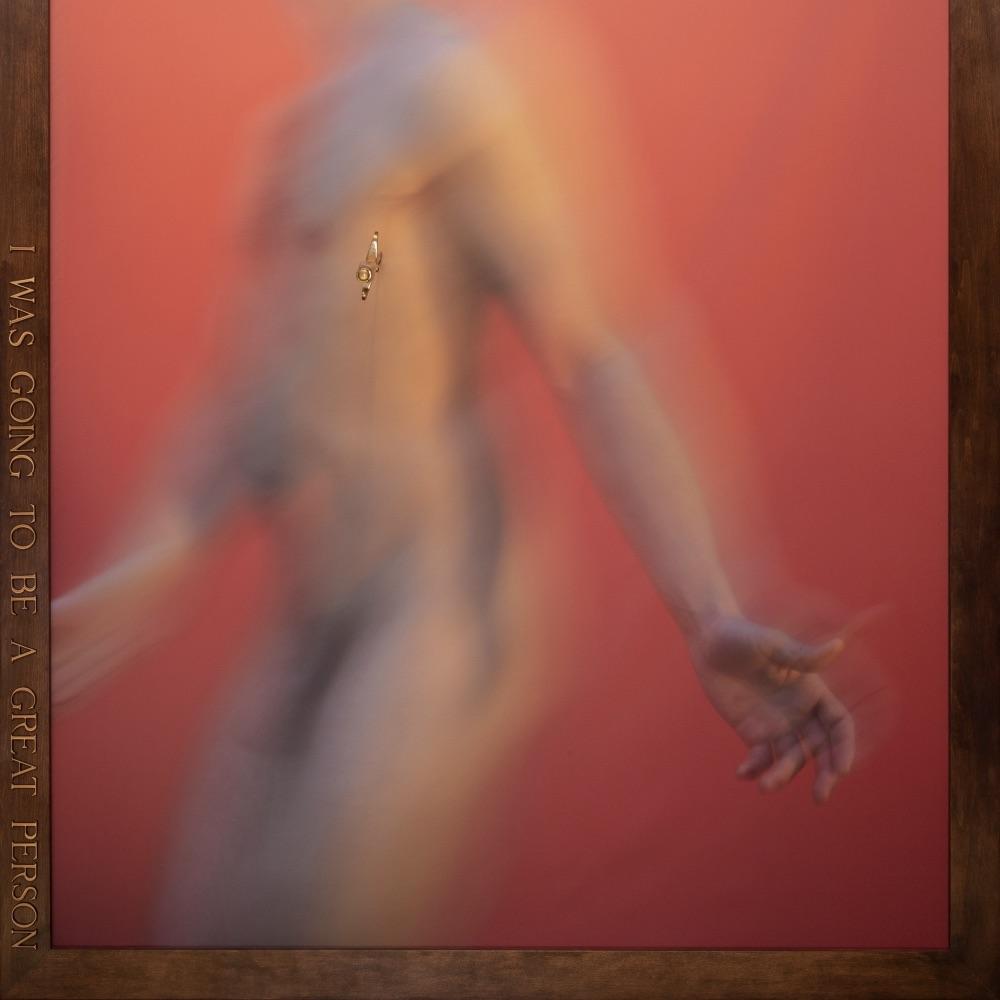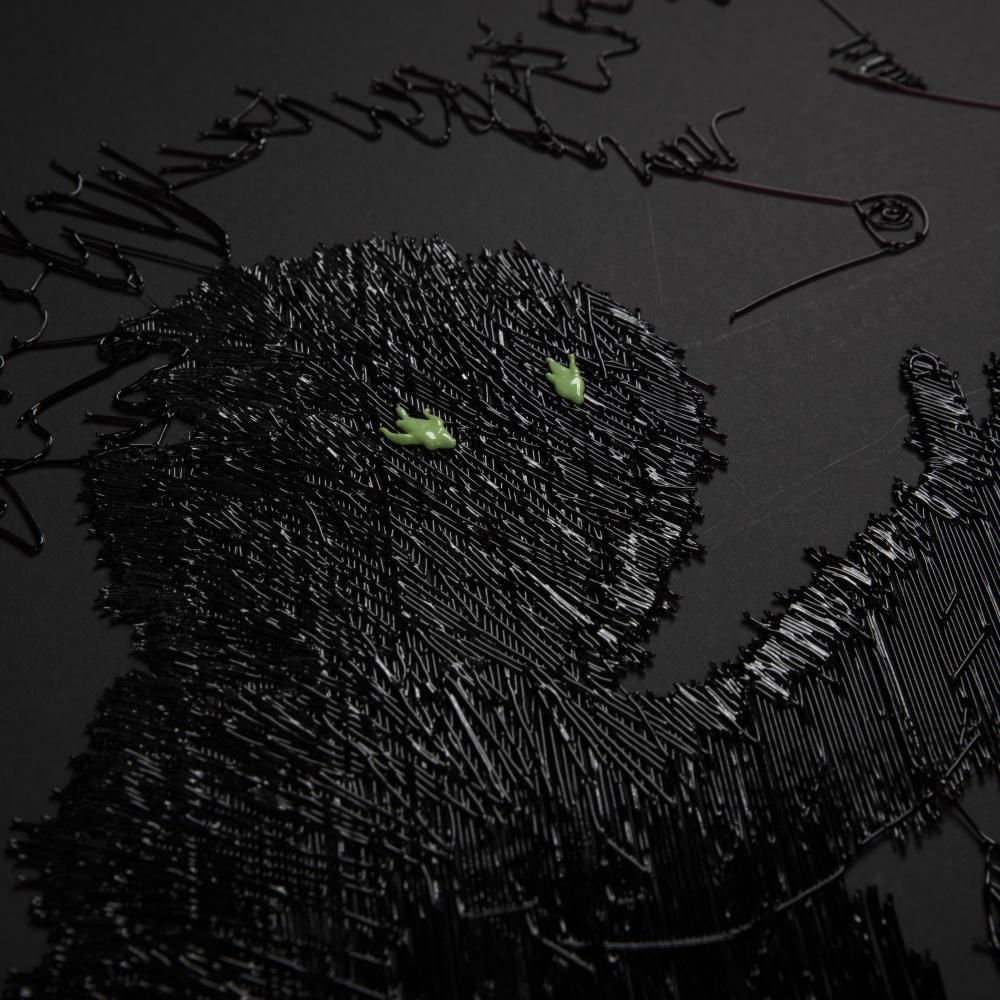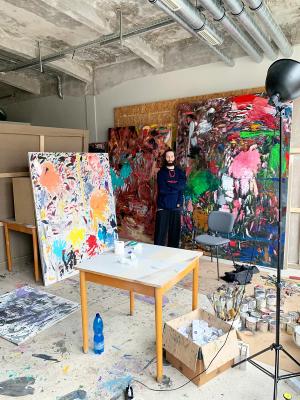
Michal Rapant (*1986) is a graduate of the painting studios of the Faculty of Fine Arts of the Brno University of Technology (under Vasil Artamonov) and the Academy of Fine Arts in Prague (under Vladimír Skrepl). He has already had a number of exhibitions and has been in residence at the Telegraph since the beginning of November. His works are characterized by a pastoral application of colour and expressive colouring.
When did you realise that painting was what you wanted to do in life?
Two milestones. One was when I had a dream in 2nd grade about an animal and wanted to find it in a book in the morning. Unfortunately, I didn't find it there, but I saw how the book was illustrated and felt like I could do it too. I got some paper and started drawing. First the shark, and then I redrew one animal after another. In 4th grade I started going to folk art school and I knew that's what I wanted to do. I didn't know that you could study art, that there was an academy, a high school, that you could make a living out of it. So I thought, you either can paint or you can't, it's not taught. The other milestone was when I was in restoration school and took an art class where we started doing still life, then switched to nude in tempera and that started to fulfill me. I knew that this was something I wanted to study and where I wanted to go.
When you mentioned restoration at the Brno University of Applied Sciences, you also studied furniture making at the SOU in Rousínov. Did studying woodworking influence your painting work?
I would not have discovered that I wanted to paint if I had not gone to restoration. There was a professor there, Jedlička, who guided me perfectly. He didn't give advice, but he gave impetus, so you were always on your own. Thanks to him, I extremely felt the need to study painting and go to FAVU or AVU.
What led you to choose a high school with a major in furniture design?
I was not a good student in elementary school. My grandfather led me to wood and I carved with him. At home, I would make swords and weapons and I was an Indian and a knight and a conqueror, so I was always making things. I enjoyed it and I knew I liked wood. It's a nice material. When I was choosing a high school, I was deciding between a glass cutter and a cabinet maker, but cabinet making was closer to home. I knew that I needed to put in the time to learn so I could go on to college and get my high school diploma. So I knew I would have to go on and I wanted to go into either furniture design or restoration.
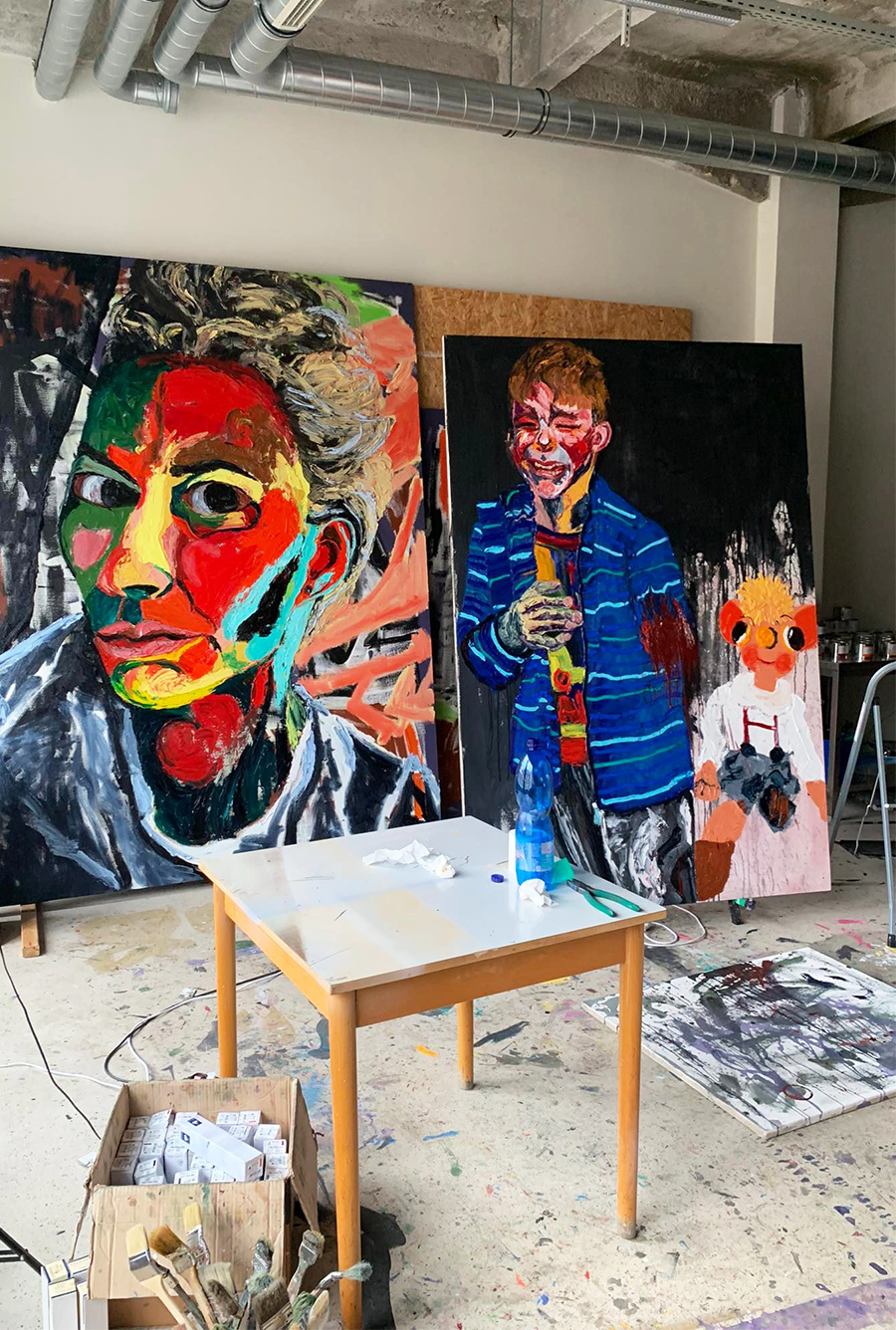
And then you got to the Faculty of Fine Arts and later to the Academy of Fine Arts in the Painting Studio.
Yes, I always found the entrance exams difficult and there was a lot of pressure, so I got into Restoration for the third time and FAVU for the second time.
History doesn't ask that anymore...
I know, but it pleases me that you have to decide what you really want and you have to give it your all. I knew I needed to study, and that's what I wanted to do. The restoration helped me get into FAVU because I did marquetry, and I was accepted based on that. In their opinion, the paintings were good, but the marquetry was better. And then I started painting.
What is your experience of studying at the Academy?
You're the best. I was under Vladimir Skrepl. He gave me a lot of freedom and rather left me alone because he saw that I was creating and there was no need to teach me anything extra. He promoted "If I don't need to, I don't teach". He would give advice on a certain thing, or a book, if somebody was confused, but I didn't need anything in his opinion. I just went about my business. I was very happy there. I transferred from Brno because there was no one there to give me extra guidance, as Václav Stratil had finished there. I needed to go one step further and AVU gave me the space.
So FAVU was also a path to the Academy.
Yes, exactly, at FAVU I met people I wouldn't have met otherwise, I got more into expressive painting through Václav. Somehow I got through to Vladimir. I liked Martin Mainer's work a lot and I wanted to join him in the atelier, but then Vladimir came closer to me.
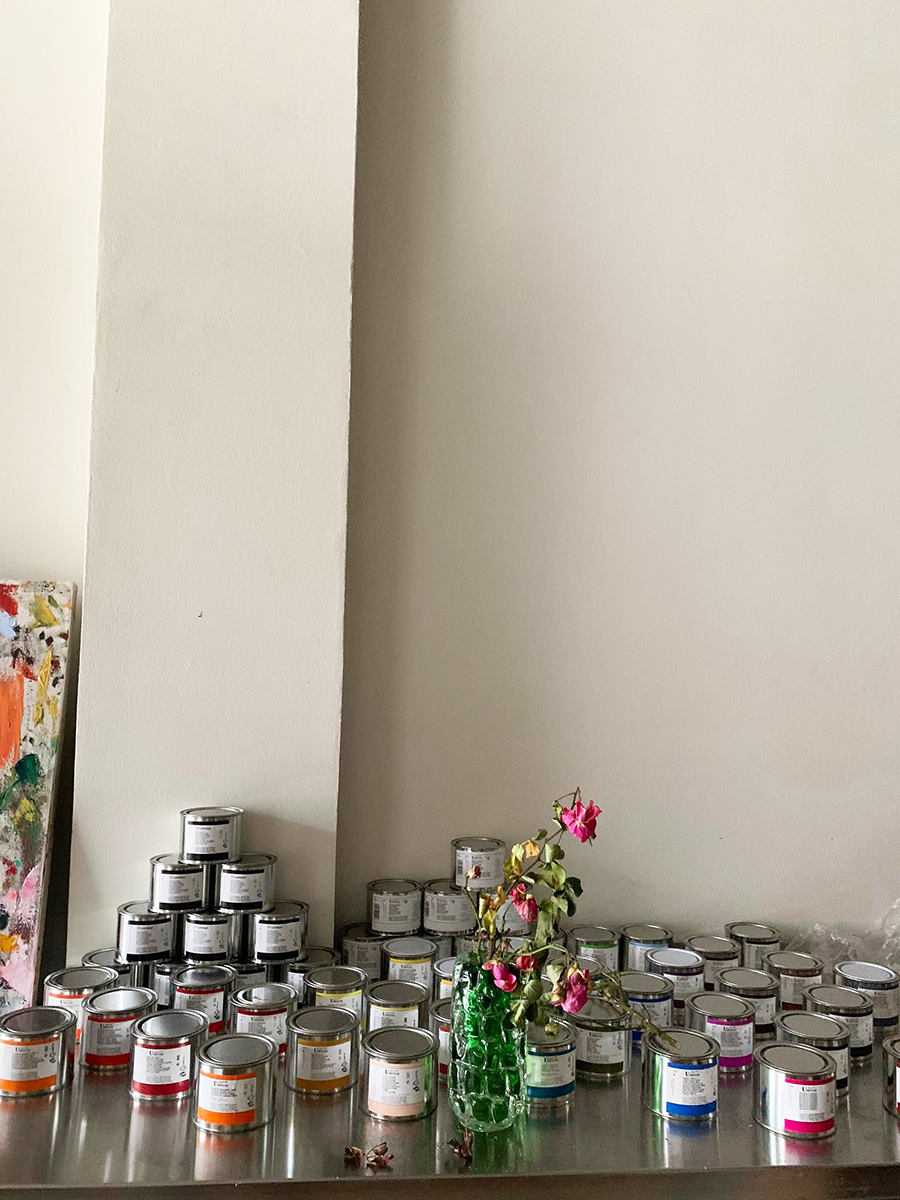
You graduated from university quite recently (2018). Do you feel that your work has taken a slightly different direction than at school, that you have more freedom?
It's just that at school there were semesters and midterms for exams where I didn't create much. Every semester every six months I had a new topic, a different interest. But it created a register of topics that I could return to and develop further over time. Which I'm doing now, because I'm continuing after my thesis with portraits and still lifes, but I'm also supplementing them with figurative things. I've moved on to personal subjects like family, relationships, friends, still life, but it's still portraits.
Your work, as you can see, is really dominated by portraits and still lifes. Why did you choose these subjects?
I've painted themes related to the war in the Middle East, ISIS, I've done wolves tearing apart the lamb of God, and some pretty tough themes. I had a dark violent period. I was quite affected by the migrant crisis through the media. It had to do with relationships and breakups, so it darkened me a lot, which lasted about a year and a half. Then I did an internship in Munich, and I came back and I was about to graduate. My mum used to say to me, "oh my, there's a beautiful hibiscus blooming, do you want to paint it?" And I said, "Mom, please, I don't paint flowers." But I've got to the stage where I'm studying for my state exams and suddenly I see slides of paintings, beautiful still lifes, Dutch masters, Matisse and his sunflowers, van Gogh right up to the present day. I found that the subject of still life was always being worked on and suddenly the urge to paint flowers came over me. After my state studies, I picked tulips on a roundabout in Prague and went painting. I started a series of teddy bears, so I combined the two. This started the era of still life, and it all culminated in my thesis, where I depicted people close to me in this way, either a portrait or a figure. Then I made still lifes out of attributes that reminded me of that person, then I started putting more than flowers in still lifes. I was interested in impermanence and I always took flowers that were not pretty, wilted, plucked, dying, thrown away, and I like to paint the beauty of the ugliness.
The theme of Vanitas - impermanence - runs through all your work. What is it that draws you to yourself?
It's that awareness of the impermanence, the mortality, that we're all going there, and the best way to do that is to realise that we don't have to be here. It's not a given that we have to be here until retirement or old age, the more we should live and not put things off and push them in front of us until sometime later. For me, it makes sense to live knowing that I want to enjoy it.
When I was looking at your work, I was struck by the rather specific titles, almost philosophical one might say. For example, "The landscape rests in peace after the battle". How do you come up with them?
I started with something that came to mind, some poeticism, or a play on words. I listen to music when I paint, so often the titles come from song lyrics. I've been using a lot of lyrics from Kato from Prago Union because he has an amazing way of working with words, where he reverses the meanings of proverbs and makes it sound good. Of course it always has to be something that resonates with me at the time I'm painting. I also draw on poetry, Shakespeare and his sonnets, but it's not artificially grafted on, it has to be from within.
Taking the painting itself, what's your painting process? Do you have a set process?
I usually do a specific object in a blank canvas. I paint the canvas with some acrylic in an expression, an ecstasy of creation, I always do several paintings at once because I don't like to waste paint. When the paint is dissolved in water, I pour the water on the canvas and some tone appears, or I play with it more so that I need to wipe the brushes into the clean canvas. That way I'll run a game of 5-6 paintings at once. Now, I went on a rampage here two days ago and it's all fired up. That'll give me a background. Or I paint into the background, but on another canvas I mix my paints, create a certain palette out of it, because a tiny palette doesn't make sense to me, so I do it straight into the canvases. This creates a composition of colours that I can build on in the future that I would never have thought to put together. Some of the backgrounds are created by me wiping my fingers and brushes and spatulas in there and the composition is very expressive and part of the painting of the particular painting. When I feel that the mood I needed or feel is there and doesn't need anything else but a motif, I wipe it away and wipe it into another painting.
Such a zero waste philosophy we could say, which is how your typical pastoral painting comes about.
Exactly, so as little waste as possible, because then the paint would stay in the rag and I'd be terribly sorry, but it's good because then you get textures and it's good to paint into them. Sometimes you get it all over and then you can't see anything at all, but the beginning is there, the texture, and it's not clean.
You work mostly with acrylics and oils. Have you tried other techniques before or did you know that these would help you express yourself best?
I've done tempera for restoration work, it was fine for me, but it's not as durable. I like durable things. Knowing that they will last. I like sculpture and statues, but I like bronze statues, material that will survive. I don't want to think about the impermanence of things, I want them to survive here, so oil is great for that and it's lightfast. I don't paint shapes with acrylic, just the underpainting because it's matte and has different tones and character. The painting then stands out a lot, it's glossy and richer than the background.
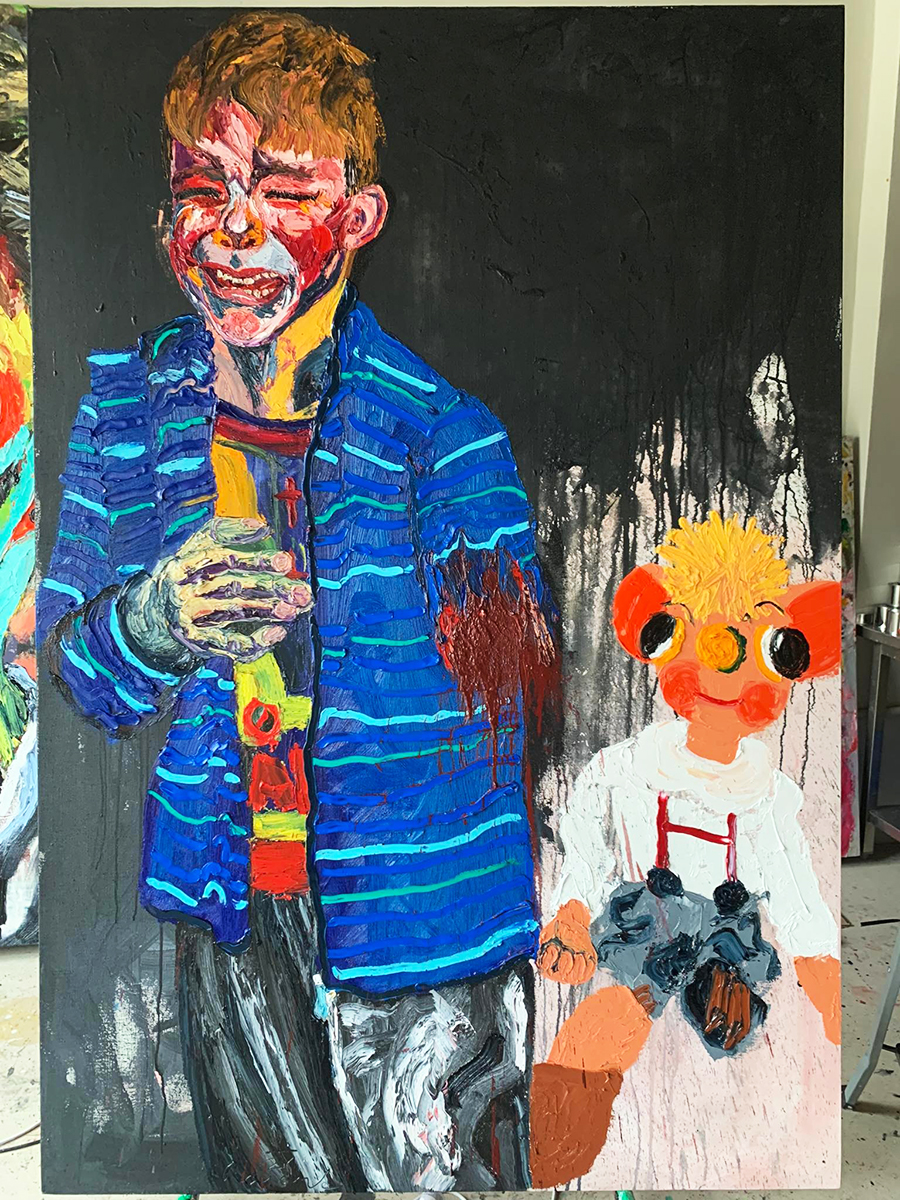
In all the works we see an expressive and vivid color palette reminiscent of German Expressionism and Fauvism. Were you influenced by these movements, or did it somehow come out of you?
That's what came out of college. I went to college quite uninitiated, I didn't have any extra training in theory. My friend Bára Kachlíková helped me a lot with that. We were drawing a classical antique white bust and she told me, "Paint with the colours you see there". You focus on it and suddenly you see, there's a tone of orange from the light and there's a reflection of the mat and suddenly it's colored in. No light tinting, but I was thrilled with the vibrancy of the color. So for me, that's how it came out, and then I was getting back to it in the spirit of theory. Before FAVU, I took a course in Brno with Samuel Pauc and Lyuben Petrov, where I learned how to stretch canvases, and I haven't painted on anything else since. Then I started to have an idea about expressionists, fauvists and neo-expressionism. Basquiat, that was a discovery for me, that's exactly what I feel I want to create. He excited me, he was actually one of my first big sources of inspiration. As he was creating, doing backgrounds, layering, journaling. Seeing his work live in an exhibition was an experience.
Speaking of exhibitions. What did you think of the German Painting Now exhibition that was on display at the Telegraph Gallery at the beginning of your residency? Do you have a favourite painting?
I have a couple of favourites, I like the colour scheme in Jonas Burgert's hornets with the turquoise background. Daniel Richter, Martin Eder, those are intense paintings. I like the colors, I like the dynamics, and I can't calm myself down and play with an image for long. One is either a sprinter or an endurance. I need to get the energy and the idea out of myself.
Has your time at the Telegraph and in Olomouc itself affected you yet?
Certainly the pleasant mood, the space and the diffused light in the studio. I feel good here. Overall, the Telegraph has a very good effect on me, so I'm planning to go to the hub tonight and finish the website. It's more pleasant there, there are flowers and I'm right there for the activity.
By Tereza Holoubková, Telegraph Gallery



